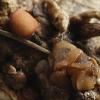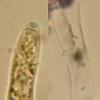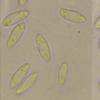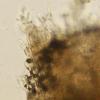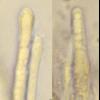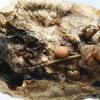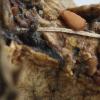
15-12-2025 15:48
 Danny Newman
Danny Newman
Melanospora cf. lagenaria on old, rotting, fallen

15-12-2025 15:54
 Johan Boonefaes
Johan Boonefaes
Unknown anamorph found on the ground in coastal sa

15-12-2025 21:11
 Hardware Tony
Hardware Tony
Small clavate hairs, negative croziers and IKI bb

15-12-2025 07:09
 Danny Newman
Danny Newman
indet. Rutstroemiaceae sp. on unk. fallen leavesMc

15-12-2025 07:05
 Danny Newman
Danny Newman
Pseudosclerococcum golindoi (det: Zotto)near Cosb

15-12-2025 11:49
 Danny Newman
Danny Newman
ITS sequences from the following two collections B

15-12-2025 12:34
 Danny Newman
Danny Newman
indet. Rhytismataceae on oak leafnear Purchase Roa

09-12-2025 12:06
 Andgelo Mombert
Andgelo Mombert
Bonjour,Je recherche l'article concernant Hypobryo
Inoperculate on Hedera
Viktorie Halasu,
24-02-2017 16:16
 Hello forum,
Hello forum,yesterday I found this disco, in small clusters on a dead stem of Hedera helix on wet ground. Apothecia about 1-1,5 mm diam, light brown, with darker margin and receptacle.
Medúlla looks like t. porrecta, ectal excipulum = t. globulosa-angularis. (edit: Excipulum is three-layered, see below.) There are some CRB+ (blue) vacuoles in outermost layer of excipulum.
Asci IKI+ (blue), croziers+, 8-spored, (uniseriate?).
Spores narrowly elipsoid, slightly inequipolar, * (8,6) 9,2-10,6 (12,3) × (2,8) 3,2-3,7 (3,9) um, M = 9,9 × 3,4, Q = 2,6-2,9-3,2 (in water), smooth, two polar groups of small LBs, OCI = cca 2, probably uninucleate, with a loosening sheath.
Paraphyses cylindrical to slightly clavate, with long CRB+ (light blue) vacuoles.
I would much welcome your advice, where to start looking for this species, in what family. Or what other characters to check.
Thank you in advance.
Viktorie
Hans-Otto Baral,
24-02-2017 17:56

Re : Inoperculate on Hedera
Hmm, I cannot say. How large are these excipular cells, they look like 20 µm diam. or so.
Did you see any living paraphyses and their contents?
Did you see any living paraphyses and their contents?
Viktorie Halasu,
25-02-2017 19:44

Re : Inoperculate on Hedera
Hello Zotto,
I'm sorry, last time I interpreted the structure wrongly. It's as follows:
- hymenium, cca 85-100 um
- subhymenium, light brown, small cells, cca 40-45 um
- textura intricata, hyaline, cca 60-65 um
- textura porrecta, hyaline, cca 55-65 um
- textura angularis(-globulosa), cca 80-90 um, individual cells 11,7-22,4 (25) × 10-14,6 (20) um with brown walls
- a layer of very small isodiametric cells, only a few rows, cells 6-7 um diam. Not sure, if this layer covers the whole receptacle, or just a part. Observed near margin, under the clavate cells.
- at the margin and below it there are hyaline clavate cells on the surface, 3,5-6 um thick
Paraphyses contain small yellowish vacuoles, cca 0,5-1,4 um diam, coalescing rather quickly (compared to what I'm used to see with operculates). I'm not sure if there are some tiny crystals on the margin or not.
Hope this helped a bit.
Viktorie
I'm sorry, last time I interpreted the structure wrongly. It's as follows:
- hymenium, cca 85-100 um
- subhymenium, light brown, small cells, cca 40-45 um
- textura intricata, hyaline, cca 60-65 um
- textura porrecta, hyaline, cca 55-65 um
- textura angularis(-globulosa), cca 80-90 um, individual cells 11,7-22,4 (25) × 10-14,6 (20) um with brown walls
- a layer of very small isodiametric cells, only a few rows, cells 6-7 um diam. Not sure, if this layer covers the whole receptacle, or just a part. Observed near margin, under the clavate cells.
- at the margin and below it there are hyaline clavate cells on the surface, 3,5-6 um thick
Paraphyses contain small yellowish vacuoles, cca 0,5-1,4 um diam, coalescing rather quickly (compared to what I'm used to see with operculates). I'm not sure if there are some tiny crystals on the margin or not.
Hope this helped a bit.
Viktorie
Hans-Otto Baral,
25-02-2017 20:35

Re : Inoperculate on Hedera
This is good. The VBs in the paraphyses support my idea that it could be a Cenangiaceae. But I have nothing on Hedera in my database.
If there is more than a few apothecia it might be that Kadri pärtel is interested to study this.
Zotto
If there is more than a few apothecia it might be that Kadri pärtel is interested to study this.
Zotto
Viktorie Halasu,
25-02-2017 21:30

Re : Inoperculate on Hedera
Oh, that's a nice surprise. Thank you very much. I'll ask her.
On the photo below, that's all there is. And there are already some hyaline hyphae developing all over the wood, so I guess I have to put it to dry tomorrow at the last. I'll try next weekend to look for more, it's in a city park.
Another idea - there is also some pyrenomycete growing in fissures in the bark and it looks this brown fungus is growing in the same places. Is there anything in Cenangiaceae with some association with pyrenomycetes?
On the photo below, that's all there is. And there are already some hyaline hyphae developing all over the wood, so I guess I have to put it to dry tomorrow at the last. I'll try next weekend to look for more, it's in a city park.
Another idea - there is also some pyrenomycete growing in fissures in the bark and it looks this brown fungus is growing in the same places. Is there anything in Cenangiaceae with some association with pyrenomycetes?
Hans-Otto Baral,
25-02-2017 22:02

Re : Inoperculate on Hedera
I actually don't remember such association with other fungi in that family.
Salvador Tello,
26-02-2017 13:08
Re : Inoperculate on Hedera
Hola Viktorie y Zotto.
Pienso que es el mismo hongo que recogí en 2013 creciendo en madera de Prunus persica.
http://www.ascofrance.fr/search_forum/21391
Pienso que es el mismo hongo que recogí en 2013 creciendo en madera de Prunus persica.
http://www.ascofrance.fr/search_forum/21391
Hans-Otto Baral,
26-02-2017 16:20

Re : Inoperculate on Hedera
Indeed, it looks very similar! Spore size fits well.
